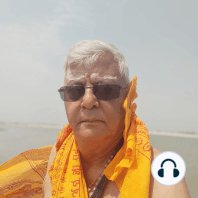1 min listen

Hinduism in Ancient China Sri Nataraja Kalari Payatru and More Evidence
Hinduism in Ancient China Sri Nataraja Kalari Payatru and More Evidence
ratings:
Length:
3 minutes
Released:
Oct 12, 2022
Format:
Podcast episode
Description
The connection between Hinduism and China runs deep.
I have recently posted an article on the connection between China and the influence of Ancient Hinduism in Chinese Religion.
Before the advent of Buddhism in China Hinduism was prevalent in China.
The spread of Hindu practices did not stop with the worship of Hindu Gods.
Unorthodox systems Vaiseshika ,Nyaya, Martial Arts,Kalari, Weapons like Vajra also found their way into China.
Names of the Deities were changed to suit the local conditions.
In this process, Lord Nataraja also finds a place in China as a Deity, a Protector.
”
“Prior to and during the life of the Buddha various principles were embodied within the warrior caste known as theKsatreya (Japanese: Setsuri). This title – stemming from Sanskrit root Ksetr meaning “power,” described an elite force of usually royal or noble-born warriors who were trained from infancy in a wide variety of military and martial arts, both armed and unarmed.
In China, the Ksatreya were considered to have descended from the deity Ping Wang (Japanese: Byo O), the “Lord of those who keep things calm.” Ksatreyas were like the Peace force – to keep kings and people in order. Military commanders were called Senani – a name reminiscent of the Japanese term Sensei which describes a similar status. The Japanese samurai also had similar traits to the Ksatreya. Their battle practices and techniques are often so close to that of the Ksatreya that we must assume the former came from India perhaps via China. The traditions of sacred Swords, of honorable self-sacrifice, and service to one’s Lord are all found first in India.
“In ancient Hinduism, nata was acknowledged as a spiritual study and conferred as a ruling deity, Nataraja, representing the awakening of wisdom through physical and mental concentration. However, after the Muslim invasion of India and its brutal destruction of Buddhist and Hindu culture and religion, the Ksatreya art of nata was dispersed and many of its teachers slain. This indigenous martial arts, under the name of Kalari or Kalaripayit exists only in South India today. Originating at least 1,300 years ago, India’s Kalaripayit is the oldest martial art taught today. It is also the most potentially violent, because students advance from unarmed combat to the use of swords, sharpened flexible metal lashes, and peculiar three-bladed daggers.
When Buddhism came to influence India (circa 500 B.c), the Deity Nataraja was converted to become one of the four protectors of Buddhism, and was renamed Nar (y)ayana Deva (Chinese: Na Lo Yen Tien). He is said to be a protector of the Eastern Hemisphere of the mandala.”
More @ Ramanisblog, Ramanisvlog, Ramanispodcast.
---
Send in a voice message: https://anchor.fm/ramanispodcast/message
I have recently posted an article on the connection between China and the influence of Ancient Hinduism in Chinese Religion.
Before the advent of Buddhism in China Hinduism was prevalent in China.
The spread of Hindu practices did not stop with the worship of Hindu Gods.
Unorthodox systems Vaiseshika ,Nyaya, Martial Arts,Kalari, Weapons like Vajra also found their way into China.
Names of the Deities were changed to suit the local conditions.
In this process, Lord Nataraja also finds a place in China as a Deity, a Protector.
”
“Prior to and during the life of the Buddha various principles were embodied within the warrior caste known as theKsatreya (Japanese: Setsuri). This title – stemming from Sanskrit root Ksetr meaning “power,” described an elite force of usually royal or noble-born warriors who were trained from infancy in a wide variety of military and martial arts, both armed and unarmed.
In China, the Ksatreya were considered to have descended from the deity Ping Wang (Japanese: Byo O), the “Lord of those who keep things calm.” Ksatreyas were like the Peace force – to keep kings and people in order. Military commanders were called Senani – a name reminiscent of the Japanese term Sensei which describes a similar status. The Japanese samurai also had similar traits to the Ksatreya. Their battle practices and techniques are often so close to that of the Ksatreya that we must assume the former came from India perhaps via China. The traditions of sacred Swords, of honorable self-sacrifice, and service to one’s Lord are all found first in India.
“In ancient Hinduism, nata was acknowledged as a spiritual study and conferred as a ruling deity, Nataraja, representing the awakening of wisdom through physical and mental concentration. However, after the Muslim invasion of India and its brutal destruction of Buddhist and Hindu culture and religion, the Ksatreya art of nata was dispersed and many of its teachers slain. This indigenous martial arts, under the name of Kalari or Kalaripayit exists only in South India today. Originating at least 1,300 years ago, India’s Kalaripayit is the oldest martial art taught today. It is also the most potentially violent, because students advance from unarmed combat to the use of swords, sharpened flexible metal lashes, and peculiar three-bladed daggers.
When Buddhism came to influence India (circa 500 B.c), the Deity Nataraja was converted to become one of the four protectors of Buddhism, and was renamed Nar (y)ayana Deva (Chinese: Na Lo Yen Tien). He is said to be a protector of the Eastern Hemisphere of the mandala.”
More @ Ramanisblog, Ramanisvlog, Ramanispodcast.
---
Send in a voice message: https://anchor.fm/ramanispodcast/message
Released:
Oct 12, 2022
Format:
Podcast episode
Titles in the series (100)
Know Hinduism,Practices It's presence Throughout the ancient world.Unique Temples by Hinduism History Practices Mantras